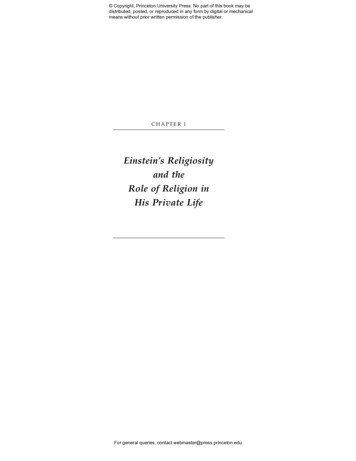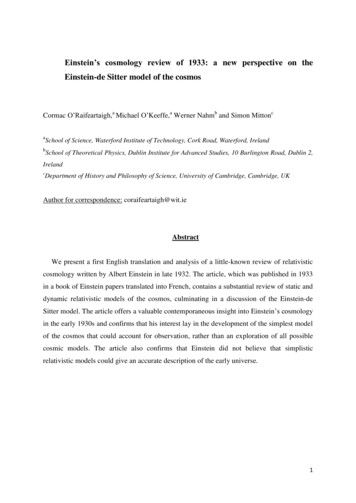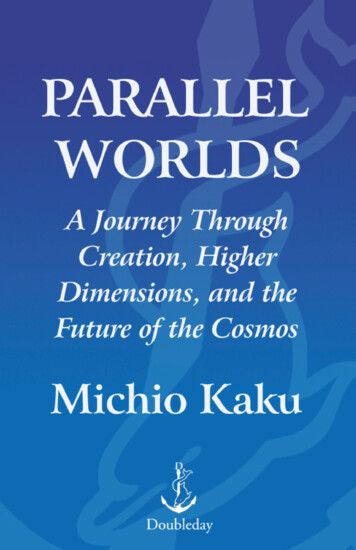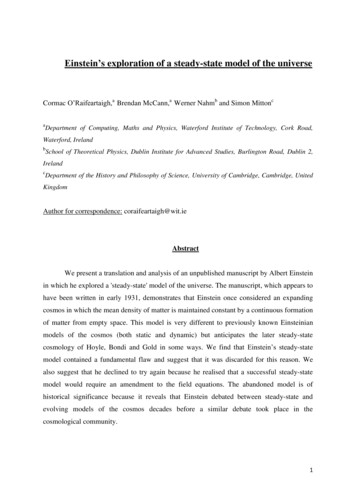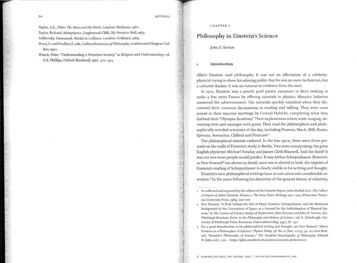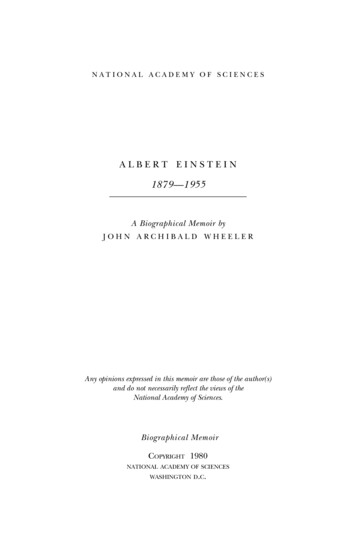
Transcription
RELATIVITYThe Special and General TheoryAlbert EinsteinTranslated by Robert W. LawsonIntroduction by Roger PenroseCommentary by Robert Gerochwith a Historical Essay by David C. CassidyThe Masterpiece Science EditionPi PressNew York
PI PRESSAn imprint of Pearson Education, Inc.1185 Avenue of the Americas, New York, New York 10036Commentary and Historical Essay 2005 by Pearson Education, Inc.Introduction by Roger Penrose 2004, 2005Original version of Roger Penrose’s Introduction first published by TheFolio Society Ltd in 2004. Reprinted by arrangement with The FolioSociety Ltd.Pi Press offers discounts for bulk purchases. For more information, pleasecontact U.S. Corporate and Government Sales, 1-800-382-3419, corpsales@pearsontechgroup.com. For sales outside the U.S., please contactInternational Sales at international@pearsoned.com.Company and product names mentioned herein are the trademarks orregistered trademarks of their respective owners.Printed in the United States of AmericaFirst Printing: April 2005Library of Congress Number: 2004117390Pi Press books are listed at www.pipress.net.ISBN: 0-13-186261-8Pearson Education LTD.Pearson Education Australia PTY, Limited.Pearson Education Singapore, Pte. Ltd.Pearson Education North Asia, Ltd.Pearson Education Canada, Ltd.Pearson Educatión de Mexico, S.A. de C.V.Pearson Education—JapanPearson Education Malaysia, Pte. Ltd.
CONTENTSIntroduction by Roger PenroseNote on the TextixxxviiRelativity: The Special and General Theory1Preface3PART ITHE SPECIAL THEORY OF RELATIVITY1. Physical Meaning of Geometrical Propositions52. The System of Co-ordinates93. Space and Time in Classical Mechanics134. The Galileian System of Co-ordinates165. The Principle of Relativity(In the Restricted Sense)186. The Theorem of the Addition of VelocitiesEmployed in Classical Mechanics237. The Apparent Incompatibility of theLaw of Propagation of Light with thePrinciple of Relativity258. On the Idea of Time in Physics299. The Relativity of Simultaneity3410. On the Relativity of the Conceptionof Distance38
viRELATIVITY11. The Lorentz Transformation4012. The Behaviour of Measuring-Rodsand Clocks in Motion4713. Theorem of the Addition of Velocities.The Experiment of Fizeau5114. The Heuristic Value of the Theory ofRelativity5615. General Results of the Theory5816. Experience and the Special Theoryof Relativity6517. Minkowski’s Four-Dimensional Space72PART IITHE GENERAL THEORY OF RELATIVITY18. Special and General Principle of Relativity7719. The Gravitational Field8220. The Equality of Inertial and GravitationalMass as an Argument for the GeneralPostulate of Relativity8621. In What Respects Are the Foundations ofClassical Mechanics and of the SpecialTheory of Relativity Unsatisfactory?9222. A Few Inferences from the GeneralPrinciple of Relativity9523. Behaviour of Clocks and Measuring-Rodson a Rotating Body of Reference10124. Euclidean and Non-Euclidean Continuum10625. Gaussian Co-ordinates111
Contentsvii26. The Space-Time Continuum of the SpecialTheory of Relativity Considered as aEuclidean Continuum11627. The Space-Time Continuum of the GeneralTheory of Relativity Is Not a EuclideanContinuum11928. Exact Formulation of the GeneralPrinciple of Relativity12329. The Solution of the Problem of Gravitationon the Basis of the General Principle ofRelativity127PART IIICONSIDERATIONS ON THEUNIVERSE AS A WHOLE30. Cosmological Difficulties of Newton’sTheory13331. The Possibility of a “Finite” and Yet “Unbounded”Universe13632. The Structure of Space According to theGeneral Theory of Relativity143APPENDIXES1. Simple Derivation of the LorentzTransformation1472. Minkowski’s Four-Dimensional Space(“World”)1553. The Experimental Confirmation of theGeneral Theory of Relativity158
viiiRELATIVITYCommentary by Robert Geroch171Preface171The Principle of Relativity179The Propagation of Light183Relativity and Intuition188Length191The Conversion of Energy to Mass195Space-Time201Inertial and Gravitational Mass205The Rotating Disk208Space-Time and General Relativity211Special Relativity and General Relativity217Cosmology220The Cultural Legacy of Relativity Theoryby David C. Cassidy225Bibliography247Index251
INTRODUCTIONRoger Penroselbert Einstein put forward his special theory ofrelativity in 1905, and he fully formulated hisgeneral theory ten years later, in 1915, publishing it in 1916. His account of these theories in this bookRelativity: The Special and General Theory first appeared(in the original German edition) also in 1916. It isremarkable—and, in my view, very gratifying—that heshould have produced such an account for the lay publicso soon after his general theory was completed. That theory, in particular, presented an extraordinary and revolutionary view of the physical world, providing profoundnew insights for our conceptions of space, time, andgravitation. This view has now superbly survived the testsof time. When Einstein first put forward his general theory almost ninety years ago, there was inevitably a deepand widespread curiosity, among the general public, as tothe actual nature of his revolutionary ideas, and there wasan equally inevitable scope for misunderstandings of various kinds. There was, accordingly, an immediate needA
xRELATIVITYfor an accessible account from the master himself. Relativity helped enormously in minimizing such misunderstandings. But, even today, there are many physicists who have not fully come to terms with the revolutions in physical world-view that Einstein presented.The reprinting of Einstein’s account to coincide withthe centenary of the special theory is therefore indeedtimely. In this edition we are also fortunate in havingthe advantage of an excellent exposition of Einstein’sfoundational ideas on relativity from a more modernperspective in Robert Geroch’s commentary.It should be pointed out that of these two relativityrevolutions, it was the general theory that was Einstein’s most uniquely original contribution. Specialrelativity—the relativity theory that Einstein put forward, among other fundamental advances, in what hasbecome known as his “Miraculous Year” of 1905—wasfar less uniquely Einstein’s own achievement. That theory was concerned with the puzzling transformationsthat mix up space and time, as is needed when the relative velocity between the reference frames of differentobservers approaches that of light. But these transformations had been in the air for some time prior toEinstein entering the scene. Others before him, particularly the outstanding Dutch physicist Hendrik
IntroductionxiAntoon Lorentz and the great French mathematicianHenri Poincaré, had already formulated the essentialideas and transformations several years before Einstein—although they had not appreciated the fullnature of the revolution, nor the virtue of taking therelativity principle as axiomatic for physical forcesgenerally. (Apparently the British physicist Joseph Larmor also had these transformations before both ofthem, and there were partial results of this nature earlier still, by the German physicist Woldemar Voigt andthe Irishman George Francis FitzGerald.) Moreover, itis my view that even Einstein had not fully understoodthe nature of special relativity in 1905, as it was notuntil 1908 that the final mathematical insights wereprovided by the highly original Russian-Germangeometer Hermann Minkowski (who had, coincidentally, been one of Einstein’s teachers at the FederalInstitute of Technology in Zurich in the late 1890s). Itwas Minkowski’s idea to combine time with space, andto describe physical processes as inhabitants of thefour-dimensional space, now referred to as space-time.It took Einstein some while to appreciate the virtueof Minkowski’s four-dimensional perspective. Even inthe account that he gives here, he betrays some uneasewith Minkowski’s viewpoint, emphasizing the analogy
xiiRELATIVITYwith Euclidean geometry, but with an “imaginary”time-coordinate (i.e., measured in units involving 1 , which I regard as somewhat misleading) and hedoes not describe this space-time geometry in the waythat I believe to be most physically direct. Physicallyrealizable curves in space-time are timelike, and hence,as is reflected in more modern accounts, the metric isreally supplying a measure of time to the curve, ratherthan length. In the excellent expositions by such relativity experts as John Leighton Synge and HermannBondi, it has been emphasized that space-time geometry is really chronometry rather than geometry in theordinary sense, so that it is clocks that express the metric better than the little rulers that Einstein used in hisdescriptions. Rulers do not directly measure (spacelike) space-time intervals: because they require, inaddition, some means of determination of “simultaneity,” they are rather confusing in this regard. Clocks,however, do directly provide a measure of (timelike)space-time intervals, and they directly provide a goodand superbly accurate measure the space-time geometry. (Indeed, the modern definition of a meter is nowgiven in terms of a time measure, as precisely1/299,792,458 of a light-second.) I would say that, inmany respects, this book will be enjoyed as much for
Introductionxiiiits historical insights into the time when the theory ofrelativity was young, as for its exposition of the verynature of Einstein’s wonderful theories of relativity.Einstein depended upon Minkowski’s space-timeidea for the generalizations that he needed in order toincorporate gravity into Minkowski’s picture, wherebythe general theory of relativity could be formulated.This theory was of a kind—almost unique in scientificdevelopment—where it is not unreasonable to suppose that, had Einstein not been there, the theorymight well still not have been found by anyone, a century or more later. As I mentioned earlier, the work ofmany individuals contributed to special relativity, andthe theory would still have come early in the twentiethcentury without Einstein. But the general theoryrequired a different order of originality, and it is hardto see any plausible train of thought that would haveclearly guided others to this theory.Minkowski’s geometry for special relativity was a“flat” one—basically a version of Euclid’s ancient geometry of three-dimensional space, but one whereMinkowski needed to modify Euclid’s geometry, not justfrom three to four dimensions, but also in a way that isappropriate for a theory of space-time rather than just ofspace (using what we now call a “Lorentzian” metric).
xivRELATIVITYMinkowski space provides the background for specialrelativity, but it does not incorporate gravity. WhatEinstein found that he needed was an irregular ratherthan a uniform geometry, so that Minkowski’s geometry would become distorted in complicated ways, inorder to describe all the details of a complicated gravitational field.In fact, it was fortunate for Einstein that such irregular geometries had already been studied in puremathematics (in the purely spatial context, rather thanin the “Lorentzian” space-time one), in the nineteenthcentury, by the great German mathematicians CarlFriedrich Gauss and Georg Friedrich BernhardRiemann. Gauss appears to have contemplated thatphysical space might be possibly be a non-flat (butuniform) geometry, and Riemann that the presence ofmatter might conceivably lead to a physical space withsome kind of irregular geometry. Riemann’s geometryformed an essential ingredient of Einstein’s general relativity. But it was an insight of a quite different andvery powerful kind that led Einstein to realize that thekey ingredient to space-time curvature was gravity.What was this insight? Einstein had already formulated special relativity, in which the physical laws were
Introductionxvto be the same in any “inertial” frame of reference. Inthis theory, as in Newton’s theory, an inertial frame isone in which the standard dynamical laws hold. As wemove from one inertial frame to another, uniformmotion in a straight line would translate to uniformmotion in a straight line. The key to special relativitywas that when we pass from one such frame toanother, the speed of light must remain the same. Einstein was disturbed by this restriction to frames whichare inertial, in this sense, and he tried to see how itcould be possible for the physical laws to be the same,also, in a non-inertial (accelerating) frame. This issuewas brilliantly solved by “the happiest thought” in Einstein’s life, when he realized, while sitting in a chair inthe Bern patent office, that “If a person falls freely hewill not feel his own weight.” In other words, thephysics in an accelerating frame differs from that in aninertial one merely by an effective gravitational field.This he termed “the principle of equivalence,” i.e., theequivalence of acceleration to a gravitational field. Ithad, in effect, been known to Galileo (all bodies fallwith the same acceleration in a gravitational field), buthad lain largely unappreciated for over three hundredyears. The key idea of general relativity, where gravity
xviRELATIVITYnow enters the picture, is that the notion of “inertialframe” needs to be reconsidered. Einstein’s new notionof inertial frame differs from that of Newton. To Newton, a frame fixed on the Earth (ignoring the Earth’srotation) would be inertial; but to Einstein, such aframe would not be inertial. Instead, a freely fallingframe, in the Earth’s gravitational field, would count asinertial. Einstein’s innovation, when gravitationalfields are present, was to define the inertial ones to bewhere an observer feels no gravitational (or acceleration) force.Einstein’s ability to base a theory of gravity on thisone key principle, together with another of his discoveries during the “Miraculous Year” of 1905, that massand energy are basically the same thing (E mc2), andhis realization that this would lead him to a theorybased on curved space-time, was an astoundingachievement—one matched only by the extraordinaryprecision that general relativity is now found to have(seen particularly in observations of the binary pulsarPSR1913 16), and by the utility that general-relativisticeffects have in cosmology, through the effects of gravitational lensing. Even what Einstein considered to behis “greatest mistake,” namely his introduction of acosmological constant in 1917 (which had prevented
Introductionxviihim from predicting the expansion of the universe)has turned out to be a required ingredient of moderncosmology since 1998.Einstein’s considerations of cosmology, asdescribed here, are fascinating. Prior to Einstein’s theory, almost nothing reliable could be said about thestructure of the universe as a whole. But Einstein wasquick to realize that his general theory could indeed beapplied to the entire universe. Although modernobservations were not yet available, some of the mathematical constraints that the theory provided couldnow begin to be examined. We see here, indeed, thebeginnings of the modern approach to cosmology.Einstein’s account is aimed at a level of technicalitythat makes it accessible to a general reader, and it issuccessful to a considerable degree. However, hisdescriptions in this book are minimal when it comesto the actual field equations of general relativity thathe introduced in order to describe the gravitationalfield. This is in some contrast with his descriptions ofspecial relativity, where Lorentz transformations aregiven explicitly. Whereas the metric quantities gik arereferred to, the necessary (Riemann) space-timecurvature tensor quantities are not included at all,being referred to only peripherally as providing the
xviiiRELATIVITYquantities whose vanishing would provide the conditions for entirely inertial reference frames to exist (flatspace-time). Clearly Einstein felt that he could notdescribe such things in detail, in a book aimed at anentirely lay audience.This is hardly surprising, particularly for a bookwritten so soon after the discovery of general relativity.But the result was that the real nature of general relativity—which has to include the Einstein field equations—could not be fully conveyed. As I have said, he makes noattempt to explain to the reader the essential meaning ofthe notion of “space-time curvature,” which is the mathematical key to his theory. Modern popular descriptionscan take full advantage of the physical manifestation ofspace-time curvature in terms of tidal distortions (aspointed out in the 1950s by Felix Pirani and others), butthese were not available to Einstein at the time, and hisaccount inevitably falls short of providing any suchphysical interpretation of space-time curvature. In1922, he published The Meaning of Relativity, which,though still written at a popular level, contains moretechnical detail than the present work.Relativity is perhaps Einstein’s most widely knownbook. Although he clearly demonstrates a bold confidence when describing his actual physical ideas, I feel
Introductionxixthat he exhibits a certain surprising insecurity in hisactual ability to convey, in an elegant way, these ideasin words. At the beginning of the book, he quotes withapproval a comment made by the great physicist Ludwig Boltzmann that “matters of elegance ought to beleft to the tailor and to the cobbler.” Yet there is a definite elegance in Einstein’s writings; when at its fullest,such elegance makes the reading easier. Nevertheless,there is a certain unevenness in the writing; the passages which flow most smoothly are those where Einstein is most comfortable with the concepts he isdescribing. He is perhaps at his most awkward (andeven repetitive) when describing the roles of coordinate systems and frames of reference, using the curiousand confusing analogy of a mollusc (or “referencemollusc”—his German word being “Bezugsmolluske”), indicating that he apparently thought of acoordinate system as a physical thing, swimmingaround like some soft marine invertebrate which couldchange its shape with time. (It took the mathematicianHermann Weyl to provide the modern viewpoint withregard to coordinates; see the fifth edition of his SpaceTime-Matter [1923].) But he is at his most inspiringwhen describing his powerful physical ideas and hisnovel global insights, like the principle of equivalence
xxRELATIVITYand his speculations concerning the global nature ofthe universe.The present edition includes material that wasadded in the 1920 English translation, but not themore recent material of the enlarged edition publishedin January 1954, the year before Einstein died, inwhich he made a brief mention of his later ideas forobtaining a “unified field theory,” according to whichelectromagnetism as well as gravity were to bedescribed. It has to be said that these grand ideas thatEinstein played with at the end of his life did not reallyamount to anything of unambiguous significance. It isregarded as a particular weakness of Einstein’sapproaches to the formulation of a unified field theorythat he appeared to make no attempt to incorporatephysical interactions other than gravitational or electromagnetic into his unified schemes. Einstein is alsocommonly regarded as having lost touch, in his lateryears, with the developments of modern physics—aquantum physics that he had himself been instrumental in initiating—through his inability to accept theemergent tenets of the resulting quantum-mechanicaltheory. Yet, in my opinion, there is some deep truth inEinstein’s difficulties with the subjectivity and lack ofrealism in the way that quantum theory has developed.
IntroductionxxiI would concur with him that modern quantumtheory is an incomplete theory, and that new developments must be waiting in the wings that may wellsupply us with a new quantum revolution, perhapscomparable with Einstein’s own general relativity.Indeed, it is my personal view that the very insightsthat drew Einstein to formulate general relativity, mostparticularly the principle of equivalence, may supplyone of the vital links to such a theory. But this is a matter for the future, and perhaps a new Einstein!Since Einstein’s death in 1955, there have beenmany developments of importance in the subject ofgeneral relativity. Perhaps the most striking of thesehave been on the observational side, which have led toimpressively accurate confirmations of the profoundaccord that Einstein’s general theory finds with theworkings of Nature. This started in 1960, when R. V.Pound and G. A. Rebka were able to provide a convincing confirmation of Einstein’s prediction that timeis slightly slowed down in a gravitational field. Thiswas one of Einstein’s famous “three tests” of generalrelativity—which was, unfortunately, not really “definitely established by Adams in 1924, by observationson the dense companion of Sirius,” as optimisticallyremarked in a footnote by Einstein’s translator at the
xxiiRELATIVITYend of Appendix 3 to Relativity. Pound and Rebkaachieved this by comparing time rates at the bottomand the top of a 22.5 meter tower, where the rate at thetop was greater by a proportion that would amount toa mere second in 30 million years!In Appendix 3, Einstein reports on the resultsArthur Eddington’s now famous expedition to theisland of Principe in 1919, which provided a roughconfirmation of the general-relativistic prediction thatthe sun’s gravitational field would deflect light(another of the “three tests”). This has now been vastlyimproved upon, starting with quasar radio observations in 1969. Such “gravitational lensing” effects arenow used as an important observational tool in cosmology, giving a direct determination of very distantdistributions of mass.The most impressive confirmation of Einstein’stheory during his lifetime (the remaining one of the“three tests”) was an apparently anomalous orbitalprecession of the orbit of the planet Mercury. Sucheffects, together with a new “time delay effect” are nowconfirmed to great precision in the solar system as awhole in work by Irwin Shapiro and his colleagues. Todate, the most impressive test of all is in the orbitalmotions in the double neutron-star system PSR
Introductionxxiii1913 16, whose precision over a period of aboutthirty years of observation was timed, by the Nobelprize winning team of Joseph Taylor and RussellHulse, to an accuracy of about one part in a hundredmillion million, where many general-relativistic effectscontribute to this in essential ways, including theenergy loss from the system due to its emission ofgravitational waves. It may also be mentioned that, ata more familiar level of application, the effects of general relativity must be taken into account for the successful operation of GPS devices.There has been much progress also on the theoretical side. Perhaps the most impressive of these it thetheory of black holes which, despite the early work ofChandrasekhar (1931), Oppenheimer and Snyder(1939), and others, during Einstein’s lifetime, seemsnot to have been taken really seriously by him. We nowknow that gravitational collapse to a black hole canoccur without any assumption of symmetry having tobe made, and where there is no particular restrictionon the type of material composition. All that is neededis sufficient material concentrated within a smallenough region. This can happen to individual stars(of, say, ten times the mass of the sun) or in large collections of stars at galactic centers, and now there is
xxivRELATIVITYgood observational evidence for black holes arising inboth types of situation. Theoretical considerations tellus that at the central region of a black hole, Einstein’sclassical field equations (where “classical” means in theabsence of quantum mechanical considerations) mustreach their limit, leading to what we refer to as a“space-time singularity,” where matter densities andspace-time curvatures are expected to attain infinitevalues. This troublesome region is, however, anticipated to be surrounded by an “event horizon,” whichwould prevent particles or signals of any kind fromreaching the outside. Yet, in the general case, the necessary existence of such a “horizon” remains anunproved conjecture—referred to as “cosmic censorship” —arguably the most important unsolved mathematical problem of classical general relativity. On theother hand, it has been established that provided suchan event horizon indeed occurs, and if it is assumedthat the space-time is stationary, then we obtain a veryspecific black-hole geometry which had been obtainedexplicitly by Roy Kerr in 1963. As the distinguishedastrophysicist Subramanyan Chandrasekhar hasremarked, black holes are the most perfect macroscopic objects in the universe, with a mathematicaldescription which is unexpectedly simple and elegant.
IntroductionxxvThere is an important physical quantity calledentropy, possessed by physical systems, which may beregarded as a measure of how “probable” that system isto come about by chance. The fundamental second lawof thermodynamics asserts that the entropy of an isolated system increases with time (or perhaps remainsconstant). A black hole has the remarkable property, asshown by Jakob Bekenstein and Stephen Hawking, thatits entropy is a specific multiple of the surface area ofits horizon. This entropy turns out to be enormousand, because of the large black holes at the centers ofgalaxies, this black-hole entropy easily represents themajor contribution to the entropy of the known universe. Because of the second law, the entropy at thebeginning of the universe must, on the other hand, beextremely small. This beginning is represented,according to the field equations of Einstein’s generalrelativity, by another space-time singularity known asthe Big Bang, which must, therefore, be extraordinarilyspecial, or “fine tuned,” as compared with the highentropy singularities that lie at the cores of black holes.A satisfactory theory of the physics that takes place atthose regions described, classically, as “space-time singularities” would have to go beyond Einstein’s classicalgeneral relativity, and such a theory would normally be
xxviRELATIVITYreferred to as quantum gravity. It would appear to be aprime task of such a quantum-gravity theory toexplain the remarkable time asymmetry between thesingularities in black holes and that at the Big Bang,but despite half a century of concerted work, there isyet no broadly accepted theory of quantum gravity.Finally, there is the remarkable observational conclusion of 1998, now largely accepted by the community of cosmologists, that the cosmological constant thatEinstein introduced in 1917, but which he subsequently withdrew as his “greatest mistake,” actually hasa small but significant (positive) value. This has theimplication that the remote future of the universe willbe an (unexpected) exponential expansion. Thisremains something of a puzzle to theoreticians, but itrepresents one of the many challenges to be faced bycosmologists in the future, and exemplifies theextraordinary richness that has been opened up byEinstein’s fantastic world-view, according to generalrelativity, of a universe governed, up to its greatestscales, by a four-dimensional curved space-timegeometry.
NOTE ON THE TEXTinstein’s preface, thirty-two chapters, and threeappendixes that make up the text of the Masterpiece Science edition of Relativity were reproduced from the original 1920 edition. Spelling errorswere corrected, and all figures were redrawn.A † following a chapter title indicates that new commentary for that chapter can be found in Robert Geroch’scommentary section, which begins after the third appendix of Einstein’s text.E
RELATIVITYThe Special and General Theory1
PREFACE†he present book is intended, as far as possible, togive an exact insight into the theory of Relativityto those readers who, from a general scientificand philosophical point of view, are interested in thetheory, but who are not conversant with the mathematical apparatus of theoretical physics. The work presumesa standard of education corresponding to that of a university matriculation examination, and, despite theshortness of the book, a fair amount of patience andforce of will on the part of the reader. The author hasspared himself no pains in his endeavour to present themain ideas in the simplest and most intelligible form,and on the whole, in the sequence and connection inwhich they actually originated. In the interest of clearness, it appeared to me inevitable that I should repeatmyself frequently, without paying the slightest attentionto the elegance of the presentation. I adhered scrupulously to the precept of that brilliant theoretical physicist, L. Boltzmann, according to whom matters ofT3
4Prefaceelegance ought to be left to the tailor and to the cobbler.I make no pretence of having with-held from the readerdifficulties which are inherent to the subject. On theother hand, I have purposely treated the empiricalphysical foundations of the theory in a “step-motherly”fashion, so that readers unfamiliar with physics may notfeel like the wanderer who was unable to see the forestfor trees. May the book bring some one a few happyhours of suggestive thought!A. EINSTEINDecember, 1916
PA RT ITHE SPECIAL THEORYOF RELATIVITY1PHYSICAL MEANING OFGEOMETRICAL PROPOSITIONSn your schooldays most of you who read this bookmade acquaintance with the noble building ofEuclid’s geometry, and you remember—perhapswith more respect than love—the magnificent structure,on the lofty staircase of which you were chased about foruncounted hours by conscientious teachers. By reason ofyour past experience, you would certainly regard everyone with disdain who should pronounce even the mostout-of-the-way proposition of this science to be untrue.But perhaps this feeling of proud certainty would leaveyou immediately if some one were to ask you: “What,then, do you mean by the assertion that th
Pi Press books are listed at www.pipress.net. ISBN: -13-186261-8 Pearson Education LTD. Pearson Education Australia PTY, Limited. Pearson Education Singapore, Pte. Ltd. Pearson Education North Asia, Ltd. Pearson Education Canada, Ltd. Pearson Educatión de Mexico, S.A. de C.V. Pearson Education—Japan Pearson Education Malaysia, Pte. Ltd. PI .

